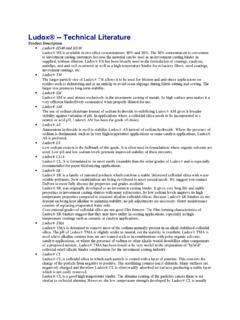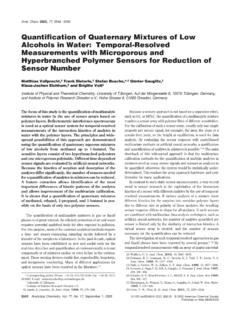Transcription of Photopolymerization reactions under visible lights ...
1 Progress in Organic Coatings 47 (2003) 16 36 Photopolymerization reactions under visible lights :principle, mechanisms and examples of Fouassier , X. Allonas, D. BurgetD partement de Photochimie G n rale, UMR n 7525, Ecole Nationale Sup rieure de Chimie, 3 Rue Alfred Werner, 68093 Mulhouse Cedex, FranceReceived 22 June 2002 ; received in revised form 19 November 2002 ; accepted 20 December 2002 AbstractA general overview of visible light photoinduced polymerization reactions is presented. Reaction mechanisms as well as practicalefficiency in industrial applications are discussed. Several points are investigated in detail: photochemical reactivity of photoinitiatingsystem (PIS), short overview of available photoinitiators (PIs) and photosensitizers (PSs), mechanisms involved in selected examples ofdye sensitized polymerization reactions , examples of applications in pigmented coatings usable as paints, textile printing, glass reinforcedfibers, sunlight curing of waterborne latex paints, curing of inks, laser-induced polymerization reactions , high speed photopolymers forlaser imaging, PISs for computer-to-plate systems.
2 2003 Elsevier Science All rights : Photopolymerization ; visible light ; Radiation curing1. IntroductionRadiation curing technologies provide a number of eco-nomic advantages over the usual thermal operation amongthem: rapid through cure, low energy requirements, roomtemperature treatment, non-polluting and solvent-free for-mulations, low costs. They use light beams to start pho-tochemical and chemical reactions in organic materials(monomers, oligomers, polymers), to form a new poly-meric material. The UV curing of coatings and varnisheson various substrates, of paints, of adhesives, of compos-ites, etc. and the imaging area (UV curable inks, printingplates, high resolution relief imaging for microcircuits inelectronics, etc.) represent a large class of industrial appli-cations. Another area is concerned with the applicationsof laser-induced processes in monomeric and polymericmaterials to computer-to-plate laser writing, direct laserpatterning of microcircuits, 3D (three-dimensional) ma-chining, holographic devices, optical elements, informationrecording and storage, etc.
3 [1-7]. Among various factorswhich affect the efficiency of the polymerization reaction,the photoinitiator (PI) has been recognized as a key factorthat governs, in coating applications, to some extent,curing speed, through cure, tack-free index, hardness, etc. Corresponding author. Tel.:+33-3-8933-6843; fax:+ ( Fouassier).Radical, cationic and anionic polymerizations can be ini-tiated by the excitation of suitable photoinitiating systems(PISs) under lights . Most of these systems were originallysensitive to UV lights but by now a large number of varioussystems allows to extend the spectral sensitivity to visiblelights. According to the applications which are developed,the advantages of such a shift in the wavelengths used are,for example: (i) the recovery of visible photons emitted bythe Hg lamps which are lost when the light is only absorbedby a UV PI, (ii) a better matching of the emission spectrumof the light source and the absorption spectrum of the sam-ple when laser lights are used, (iii) the possibility to findspectral windows when pigmented formulations have to bepolymerized, (iv) the opportunity to use the sunlight for thecuring of outdoor present paper is focused on the use of visible lightsin Photopolymerization reactions and intends to provide.
4 (i)an approach of the photochemical reactivity of these sys-tems, (ii) an overview on the structures/properties relation-ships, (iii) an example of investigation of the processes in-volved and (iv) typical applications mostly selected amongthose developed by the Laboratory and Industrial partners inthe field of the photocuring of, varnishes, paints, inks,computer-to-plate systems. Other review papers have beenrecently published on the general aspects concerning pho-toinduced polymerization reactions [8], the reactivity of UVradical PIs[9]and photosensitizers (PSs)/PIs systems forhigh speed photopolymers[10].0300-9440/03/$ see front matter 2003 Elsevier Science All rights (03) Fouassier et al. / Progress in Organic Coatings 47 (2003) 16 3617 Scheme Background[5]Direct photoinduced polymerization reactions concern thecreation of a polymer P through a chain reaction initiatedby light (Scheme 1).
5 Since direct formation of reactive species on the monomerby light absorption is not an efficient route, the initiationstep of the polymerization reaction requires the presence ofa PI which, under light excitation, is capable of generatingthese reactive species (Scheme 2).Extension of the spectral sensitivity (that corresponds tothe best matching between the emission spectrum of the lightsource and the absorption spectrum of the formulation) canbe achieved by using (PSs): their role is to absorb the lumi-nous energy at a wavelength where PI is unable to operateand to transfer the excitation to PI. In that case, the reac-tion is defined as a sensitized photoinduced polymerization(Scheme 3).The intrinsic reactivity of a PI which plays an importantrole on curing speed determines its interest and is directlyconnected with (i) its molecular structure (which governsthe intensity of the light absorbed, the absorption wave-Scheme range, the energy or electron transfer reactions ability,etc.)
6 And (ii) the efficiency of the photophysical and pho-tochemical processes involved in the excited states (whichdetermines the yield of cleavage reactions , electron transferreactions with amines, quenching by monomer or oxygenor other additives such as, hydrogen donors (HDs), light stabilizers, interactions with PS, etc.). However, otherfactors have yet to be considered in photopolymerizationreactions: reactions in pigmented media; synergistic effects;volatility and extractability; odors, yellowing; photodegra-dation under outdoor exposure; oxygen quenching; environ-ment; interaction with stabilizers; light intensity effects, of the mechanism involved can be done byusing time resolved laser spectroscopies[4]. Except fewstudies through CIDNP-NMR and CIDEP-ESR techniques,most of the studies on the excited state processes of PIshave been carried out through transient absorption laserspectroscopy on the nanosecond time scale which providesuseful informations such as transient absorption spectra,lifetimes of excited states and rate constants of use of this kind of spectroscopy on the picosecondtime scale by employing a different experimental deviceextends the possibilities and allows the investigation of ul-trafast processes.
7 Complementary techniques such as timeresolved thermal lens spectrometry[11]and photoacousticspectroscopy[12] in which the analysis is based on themonitoring of the heat evolved from non-radiative processesoriginating from the transient states can be very evidence of ions or radical ions generation can befollowed by time resolved photoconductivity[13].3. A short overview of visible light PISsMany photosensitive systems PI and PS for radical pho-topolymerization have been developed in recent years to takeup the challenge of designing organic molecules working inwell-defined conditions of laser excitations[1-7].In radical Photopolymerization reactions , examples in-clude[1-7]: ketocoumarins and coumarins derivatives;dyes ( xanthene dyes such as eosin (EO) or Rose Ben-gal (RB), thioxanthene dyes or cyanins); thioxanthones;bis-acylphosphine oxides; peresters; pyrylium and thiopy-rylium salts in the presence of additives such as a perester;cationic dyes containing a borate anion; dyes/bis-imidazolederivatives/thiols; PS/chlorotriazine/additives; metallocenederivatives (such as titanocenes); dyes or ketones/metallo-cene derivatives/amines; cyanine dyes in the presence of ad-ditives; dyes/bis-imidazoles.
8 Miscellaneous systems such asphenoxazones, quinolinones, phthalocyanines, squaraines,squarylium containing azulenes, novel fluorone visible lightPIs, benzopyranones, rhodamines, riboflavines, RB perox-ybenzoate, PISs with good photosensitivity to the near IR,camphorquinone/peroxides, pyrromethane dye, crystal vio-let/benzofuranone derivatives, two color sensitive systems, Fouassier et al. / Progress in Organic Coatings 47 (2003) 16 36 Scheme cationic PIs (such as iron arene salts, novelaromatic sulfonium or iodonium salts) and PS/cationicPI (where PS can be hydrocarbons or ketones or metalcomplexes) can help to shift the absorption in the visiblewavelength photoacids and photobases for the generationof active species in photoresists technology are now, the design of colored species and proposals of PSfor their decomposition remains attractive state processes of photosensitive systems for laserbeams and/or conventional light sources induced polymer-ization reactions have been reported in recent works (see, in[5,6b,8-10]).
9 Typical photosensitive systems under visible lights areclassified as discussed, in[5,6b,6c,7k]:(i) One-component system (such as bis-acylphosphineoxides, iron arene salts, peresters, organic borates, ti-tanocenes, iminosulfonates, oxime esters, etc.), 4 10.(ii) Two-component system (working, through electrontransfer/proton transfer, energy transfer, photoinducedbond cleavage via electron transfer reaction, electrontransfer), 11 Fouassier et al. / Progress in Organic Coatings 47 (2003) 16 3619 Scheme 12.(iii) Three-component system (where the basic idea is to tryto enhance the photosensitivity by a judicious combina-tion of several components).In the basic concept developed several years ago[14]in a three-component system I/II/III working through elec-tron transfer (Scheme 14a) the light is absorbed by I andradicals are formed through I/II interaction.
10 Radicals Ri playing a detrimental role (through a reaction with thegrowing macromolecular chains) are quenched by use of this suitable quencher III allows to scavengethe Ri radicals and, if possible, to generate new initi-ating radicals through an electron transfer reaction. It isapparent thatRpwill increase sincekt, the rate constantof termination, decreases and new initiating species aregenerated from the deactivation process of the side rad-icals Ri . Several efficient systems have been recentlyreported, ketone (benzophenone, thioxanthone)/bromoorganic derivative or CBr4/amine; ketone (benzophe-none, thioxanthone, ketocoumarin)/amine/onium salt; dye(thioxanthene dye)/amine/onium salt, dye/amine/ketone,dye/triazine/e-donor,dy e/amine/bromoderivativeordye/CBr4.


